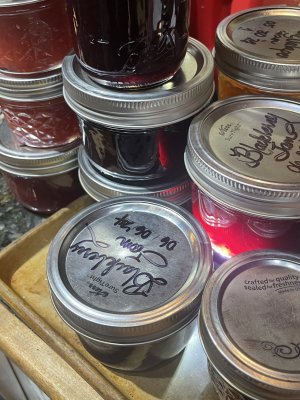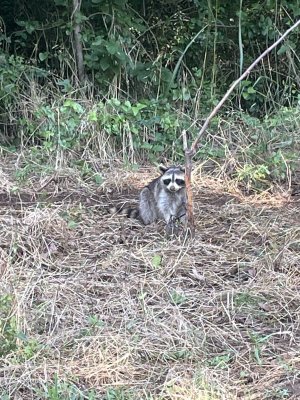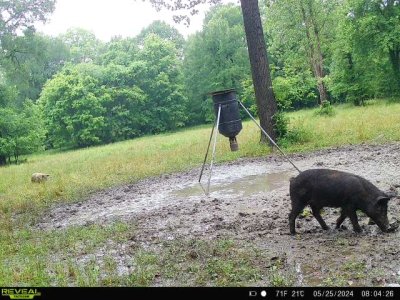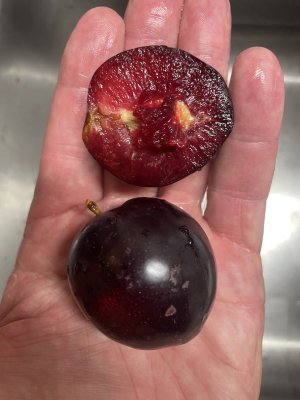-
If you are posting pictures, and they aren't posting in the correct orientation, please flush your browser cache and try again.
Edge
Safari/iOS
Chrome
You are using an out of date browser. It may not display this or other websites correctly.
You should upgrade or use an alternative browser.
You should upgrade or use an alternative browser.
G&H Farms
- Thread starter SwampCat
- Start date
My hogs graze clover like a deer. They eat the seed heads off wheat or rye. They do very little rooting on my place - except when the native pecans drop - then they root a circle around every pecan treeWhen we lased land with hogs, they would graze the Durana and rye. Never noticed them eating anything else or rooting in plots with Durana. Plots without Durana would get rooted up often.
TreeDaddy
5 year old buck +
They do the same on my plotsMy hogs graze clover like a deer. They eat the seed heads off wheat or rye. They do very little rooting on my place - except when the native pecans drop - then they root a circle around every pecan tree
They absolutely destroy the yard around the cabin,however
bill
TreeDaddy
5 year old buck +
Throw in some Everclear
Im there,dude
bill
That is the beauty of cultivated blackberries - i have weed mat along my row. No weeds. I do think wild blackberries have a more vibrant taste - but not sure how many folks could tell the difference with blackberry jam. These jars are straight out of waterbath and still hot. So thick a light wont hardly shine through. My favorite jam/jelly. I do think jam has more flavor than jellies. Plum jam right next to them - which is dang good, as is peach jam and plum jelly - just not blackberry


had to harvest some of the critter crop around my fruit trees. Too many peach pits and half eaten green apples laying on the ground under the trees for my liking. Caught one more coon, but they arent too photogenic when they are covered with mud. These were all within a stones throw or closer to my fruit trees.
I should just knock those peaches out of the young peach tree because the limbs are too small to support the weight - especially if a coon gets up there. But, a lot of peaches in this tree - white meat peaches - been waiting about three years to get these




I should just knock those peaches out of the young peach tree because the limbs are too small to support the weight - especially if a coon gets up there. But, a lot of peaches in this tree - white meat peaches - been waiting about three years to get these





Wheat field planted last fall, matured and dry a couple weeks ago. Sprayed with gly two weeks ago. Spread browntop millet ten days ago prior to a rain forecast. Rain was a little heavy and washed the seed into a lot of lower areas in the field - 5” or rain in three days. I am going to live with it. You can see millet coming up. Looks kind of washed out right now - probably too much water.

Checked on a hack n squirt area gone bad. Had forty acres done four years ago. Contractor used arsenal. Big rain right after they got done. The biggest slope on the area suffered a lot of non target kill - this area right here - maybe two acres had a lot of 8” oak - all died. Great bedding cover now - but not needed here. Still, not a horrible thing for the deer - other than the loss of some extra trees.

Did a pollinator planting last spring on about 4 acres. The johnson grass has taken over. First time I could get a tractor in there this year. Sprayed cleth but I believe the grass is way too tall. Will give it a couple weeks to see if by chance it kills it, but pretty sure I am going to have to bush hog then spray again
BenA
5 year old buck +
Plateau got rid of my johnsongrass without hurting my other stuff.View attachment 65224
Did a pollinator planting last spring on about 4 acres. The johnson grass has taken over. First time I could get a tractor in there this year. Sprayed cleth but I believe the grass is way too tall. Will give it a couple weeks to see if by chance it kills it, but pretty sure I am going to have to bush hog then spray again
Will the plateau kill nwsg? That is main reason I went with cleth to kill nwsgPlateau got rid of my johnsongrass without hurting my other stuff.
BenA
5 year old buck +
No, it didn't with my NWSG, but it cleaned up the johnsongrass.Will the plateau kill nwsg? That is main reason I went with cleth to kill nwsg
BenA
5 year old buck +
I went to look back at the research done at Purdue and UT in this document:Will the plateau kill nwsg? That is main reason I went with cleth to kill nwsg
This is what was written about thinning NWSG stands:
"Herbicides to thin rank native grasses. Various herbicides can
be used to effectively thin native grasses and increase forbs.
However, grass-selective herbicides do not reduce native grasses
enough to elicit an increase in forbs and a change in composition.
Broad-spectrum and broad-spectrum selective herbicides (e.g.,
glyphosate and imazapyr) effectively thin native grasses and
increase forbs after only one application. Herbicides to reduce
native grasses are most effective when applied in late spring or
early summer (May–June) when grasses are 18–24 inches tall and
prior to flowering, but they also may be applied later in the
summer (August–September) prior to grass senescence. If
applied in late summer, mowing or burning the stand early in
August and allowing at least 3 weeks for native grasses to regrow
may increase the effectiveness of the treatment.
We recommend imazapyr (Arsenal®, 48 oz/ac) instead of
glyphosate if legumes or brambles are present, because most
legumes and brambles are relatively tolerant of imazapyr.
However, glyphosate (2 qt/ac) should be used when sericea
lespedeza is present, because imazapyr does not control sericea
lespedeza. Glyphosate also can be used when the stand has few if
any forbs. Burning fields after treatment is recommended to
reduce thatch and stimulate the seedbank. If sprayed in May or
June, the stand can be burned in July or August to stimulate
germination of forbs and grasses before fall."
Similar threads
- Replies
- 13
- Views
- 734
- Replies
- 113
- Views
- 10K










